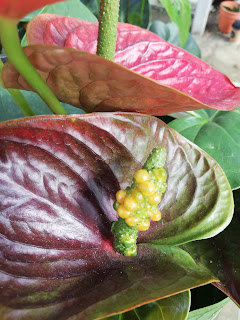FLOWERS:
The waxy heart-shaped colored petal like is known as a spathe - its a shield like leaf and supposedly protect the spadix - the rod sticking out thing - upon this are the tiny flowers that blooms and may form fruits from this erected structure.
Also these can last for many months and always in bloom. The flowers can change in color slowly fading away into green or various coloration based on their cultivar.
This particular type is actually an epipyte which works best as placing them as Vertical Garden Plant - because of this it can tolerate all levels of indirect light, but anthuriums growing in low light will have fewer flowers and will grow slower. These plants cannot tolerate direct light however, as this can burn the leaves. It grows best in bright, indirect light.
There are almost 1000 cultivar and hybrids and more introduced year after year that it may be impossible to keep track of all of them. However - I may say I'm intrigued to note that there are varieties that will be bloom more and behaves hardy in comparison with other cultivars.
Do seek out the cultivar that suits your garden conditions:
Example for my garden - I would need to select the type that is hardy with over-watering (rain) and able to handle shaded and also direct hot sun (spanning both conditions) Also - I may have to select a dwarf variety rather than a big foliage version as I would like them to be grown in a small and compact areas.
Because of these many cultivars and hybrids - I can selectively choose that particular variety that suits best in my garden condition.
Care & Growing:
LIGHT:
This particular type is actually an epipyte which works best as placing them as Vertical Garden Plant - because of this it can tolerate all levels of indirect light, but anthuriums growing in low light will have fewer flowers and will grow slower. These plants cannot tolerate direct light however, as this can burn the leaves. It grows best in bright, indirect light.
The balance of both is required - too much bright sunlight - leaves get burned.
Too less light - over shaded - no blooms.
MEDIUM:
These do best in fast draining soil medium: 50% sand and 50% cocopeat. However these do require fast draining medium good enough to keep the root ball moist but not soaking wet as it may cause root rot.
WATERING:
Because of the fast draining medium - they can tolerate good watering regime. Normally I water twice a day on a good sunny day and once a day in the morning on rainy days. I often refrain from watering if it rains in the morning.
FEEDING:
I find they do well in using foliar fertilizer especially the orchid mix types. Of course, these are much hardier than orchids - I find that they are quite resilient than most flowering plants.
PEST:
So far I had not encountered any pest for this particular one.
All of these pictures below are taken from Sg.Buloh nursery during the Chinese New Year Season. Most of them which are in plastic bags are actually imported. These are the tall big version of which I believe more care must be given as not to expose them to hot direct sunlight.
There are also the common local variety which I believe are much hardier in the lowland hot climate.
However - all of these are brought in either from Cameron Highlands or imported plants which had accustomed to cool / cold surrounding that immediate hot weather can give them a terrible shock of either Flower burns or bud drop.
The Price range are also affordable based on their rarity and plant size. The Red colored ones are considered common and easily available - I believe those are the hardy ones.
Even the Heart Shaped Leaves are still beautiful - like most Aroids - these do look like a Philodendron. Even without a Flower - they are indeed a Beauty.
































No comments:
Post a Comment